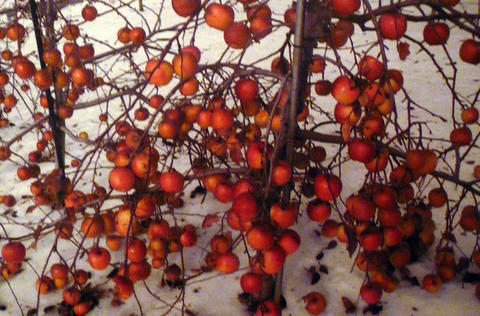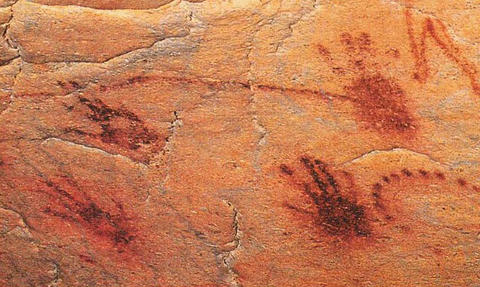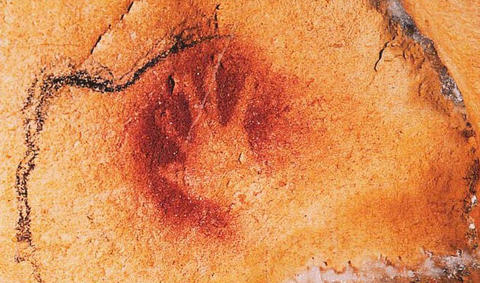Introduction

Dedication from the book: For John. Pigmented inkjet print. Richard Benson. Apples. 2007. 11 5/8 x 17 3/8" (29.5 x 44.2 cm). The Museum of Modern Art, New York. Gift of Richard Benson © Richard Benson
The Printed Picture—the book, exhibition, and now this website—is about pictures and the ways in which they are printed. Many of the pictures are “representational,” by which I mean that they attempt to show the form of some object, rather than acting as symbols in the manner of letters and numbers. When letters and numbers, whether drawn or printed, are used to communicate, they are understood through a set of meanings embedded in the language that the writer and reader share. All a letter or number has to do pictorially is to be recognized as itself and not some other character. A representational picture is different: the details of its visual structure dominate the meaning, to the point where any small change in form results in a change of meaning. Any given representational picture might have a broadly recognizable subject, and even an obvious meaning, but the specifics of its form shape that meaning.
It follows that when a representational picture becomes complex, different people may attach widely different meanings to it. To make matters worse, at any given moment in history cultural influences strongly direct our interpretation of pictures—yet since even pictures on fragile paper may outlast their makers, much of that cultural influence may have disappeared before the picture does. All this implies that it is hard to know just what any picture might “mean.” We can be sure, though, that the form of the picture is the dominant influence on how we understand it, and that is where my interest lies: not so much in meaning as in form. This book examines how pictures look—by reproducing a lot of them—but carries out that examination by describing the manner in which they were made. To my mind the making dictates the form, and whatever meaning there might be flows from those steps and from the cultural context in which the picture is viewed.
When a picture is a skillfully made drawing or painting, its meaning surely derives to a huge degree from the intention of its maker. But when a picture is a reproduction of a drawing or painting, the case is very different, because the form and therefore the meaning of this second-generation picture are then heavily influenced by the technology used to produce the reproduction. This issue has been examined beautifully by William Ivins, whose books on prints and their appearances are still the benchmarks for anyone studying the interaction of form and meaning in printed material. When the picture-making system is photography, though, everything becomes muddled, because even in original work—photographs taken out in the world—the mind of the maker has to share the driver’s seat with the form of the picture as it is shaped by the technology of photography. And when a photograph is reproduced, things get still more difficult, because such reproductions can only be made by rephotographing the photograph. It then becomes very hard to tell whether the person doing the reproduction or the technology itself might be in charge. The intention is to explore this many-layered subject through an examination of the different ways in which printed pictures are made. An underlying premise is the fact that printing, photography, and digital technology, as applied to pictures, are all aspects of a single ancient process: that of creating fixed visual forms in multiple copies. I believe that pictures are as important as language, and that together they form the glue that holds society together.
Because printing and photography have become so commonplace I have chosen to concentrate on everyday pictures rather than just those exotic birds that reside in museums. Some of the pictures found here are rare and valuable but most of them are scraps gathered through my forty years of work as a photographer, printer, and junk collector. In every case the picture accompanying the text is related to the process described, but in many cases the text does not refer to the particular picture that is illustrated. The picture is there as an example of the process but not always as an object to be discussed. As far as possible the texts follow a chronological thread, but because the various processes have originated and disappeared at different times, and because the texts and pictures are grouped by process, there is necessarily some jumping back and forth in time. The various processes and inks shown in the book were all reproduced by conventional process-color printing in photo offset lithography. The images on the website will be viewed on a computer monitor or other kind of digital screen.
We live in a time of tremendous technological change. One of the most far-reaching innovations has been the creation of moving pictures. The earliest examples of these, locked onto chemical film and projected in strips, became the ubiquitous movies. Today we find radically new versions in television, video, computer imaging, and the World Wide Web. However, what is on this site is a survey of “still” images, those fixed on paper and other substrates. I leave it to some other, far younger author to give an overview of the moving picture.
The book The Printed Picture grew out of a series of lectures given at Yale University over the last thirty years. Each time I gave one it was different, varying according to the prints I hung on the wall that day. Its pages, and the text on this website, derived from the book, still retain the tone of a lecture being delivered in the first person.
The oldest pictures we know appear on cave walls in Europe. They were drawn with carbon black, derived from burned wood or bone, and with red ocher, a naturally occurring iron compound. The oldest of these pictures, dating back as far as 30,000 years, display fully evolved representational art. Linear description is handled magnificently, shading is used to render rounded forms, and picture structure is so well handled that these paintings rival anything made since. If we look at representational painting in the West for the thousand years preceding the Renaissance, we can only shake our heads in wonder at how much had been forgotten since the artists worked in the caves.
Mixed in with the hand-drawn pictures in the caves are clear examples of printing. The most common of these printed pictures are of the human hand. Sometimes the image is dark, obviously made by impressing a pigment-covered hand onto the wall, while in other cases the hand appears as a negative, clear but surrounded by colored material. The hands we find in prehistoric caves represent two of the fundamental forms of the basic types of printing. The positive images (those made by the hand itself carrying the pigment) are examples of relief printing, the system that underlies printing with moveable type or with wood or linoleum blocks. The negative images (those blank hands surrounded by colored pigment) are examples of stencil printing, in which image-bearing pigment is passed through or around some form that holds the picture information.
We can make an argument that printing has existed as long as people have been making pictures. While The Printed Picture concentrates on pictures on paper, we should always remember that the practice of printing—of using an object to control the form of a repeated picture—has had a role in human culture from its earliest days.


Pigment prints. Artist unknown. Hands from the walls of the Chauvet cave, Ardèche, France. c. 30,000 B.C. © Jean-Marie Chauvet, Eliette Brunel Deschamps, and Christian Hillaire.